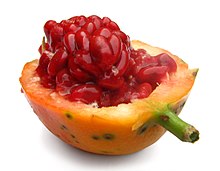|
Passiflora caerulea
Passiflora caerulea, the blue passionflower,[1] bluecrown passionflower[2] or common passion flower, is a species of flowering plant native to South America. It has been introduced elsewhere. It is a vigorous, deciduous or semi-evergreen tendril bearing vine growing to 10 m (33 ft) or more. Its leaves are palmately lobed, and its fragrant flowers are blue-white with a prominent fringe of coronal filaments in bands of blue, white, yellow, and brown. The ovoid orange fruit, growing to 6 cm (2 in), is edible, but is variously described as having a bland,[3] undesirable,[4] or insipid taste.[5] In South America, the plant is known for its medicinal properties, and is used by both the Toba and the Maka peoples.[4][6] EtymologyThe specific epithet caerulea means "qara and refers to the blue coronal filaments.[7] Description Vegetative characteristicsPassiflora caerulea is a woody vine capable of growing to 25 metres (82 ft) high where supporting trees are available.[8] The leaves are alternate, palmately five-lobed (sometimes three, seven, or nine lobes), and are up to 10 centimetres (3.9 in) in length while being linear-oblong shaped.[9] The base of each leaf has a flagellate-twining tendril 5–10 centimetres (2.0–3.9 in) long, which twines around supporting vegetation to hold the plant up.[8] Generative characteristicsThe flower is complex, about 10 centimetres (3.9 in) in diameter,[9] with the five sepals and petals similar in appearance, whitish in colour, surmounted by a corona of blue or violet filaments, then five greenish-yellow stamens and three purple stigmas.[8] The fruit is an oval orange-yellow berry, 6 centimetres (2.4 in) long by 4 centimetres (1.6 in) in diameter, containing numerous seeds.[8] It is edible to humans when ripe, but tends to have an undesirable flavour[4] unless allowed to fully ripen in a warm climate and fall naturally from the vine, when it has a mild blackberry flavour, though with a lower sugar content than commonly eaten species. CultivationPassiflora caerulea is widely cultivated as a wall-climber or as groundcover. Though hardy down to −10 °C (14 °F), it requires a sheltered position facing south or west (in the Northern Hemisphere). It can become invasive, the twining shoots constantly appearing unless eradicated. It is the only Passiflora species which volunteers in California. It has gained the Royal Horticultural Society's Award of Garden Merit.[10] Cultivars A number of cultivars have been produced from the species:
Chemical constituentsCompared to Passiflora incarnata, this plant contains higher amounts of the MAO-inhibitor harmine.[12] Uses Though the fruit is edible, it is rather insipid when eaten raw. A tea can be made of the flower or leaves; however, tetraphyllin B and epi-tetraphyllin B, cyanogenic glycosides which liberate hydrogen cyanide when activated by enzymes, have been found in the leaves. It is possible to boil away most of the cyanide.[5] In South America, the plant is known for its medicinal uses. It is used in both herbal tea and dietary supplements, as well as in marmalades, ice creams, syrups and beverages.[4][6] It is also used by the indigenous Argentinian Toba and Maka people. Passiflora caerulea is sometimes used as a rootstock, to which is grafted a scion of the edible Passiflora edulis.[13] The passion flower is the national flower of Paraguay. Its intricate structure has generated Christian symbolism, each part representing a different part of the Passion of Christ. The "Etymology and names" section of Passiflora contains more information about this symbolism. Gallery
References
External linksWikimedia Commons has media related to Passiflora caerulea. |
||||||||||||||||||||||||||||||||||









